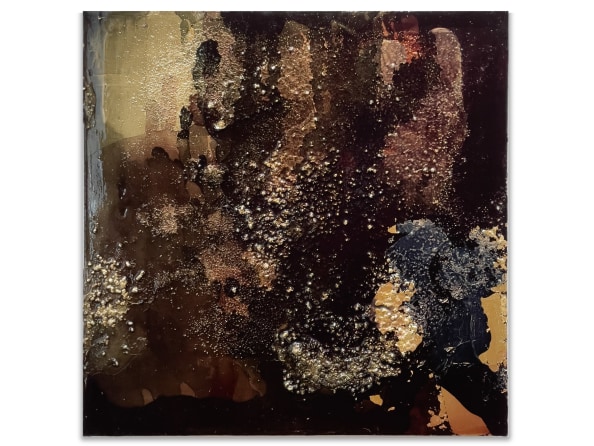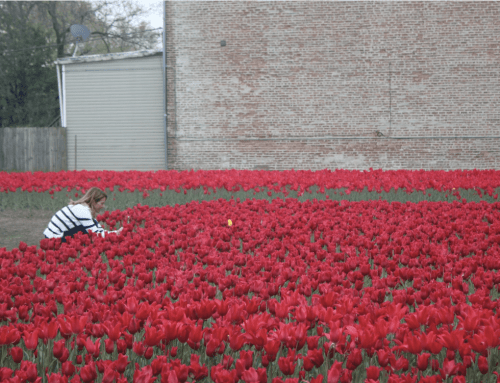

WASHINGTON PARK— Hundreds of neighbors gathered Saturday to watch thousands of red tulips bloom on the vacant lot where nearly two dozen homes once stood.
The installation, “Redefining Redlining,” was envisioned by the artist Amanda Williams with the intention of raising awareness about the ways systemic racism has created inequity on Chicago’s South and West sides.
Enjoying the installation at East 53rd Street and South Prairie Avenue in Washington Park, South Siders took family portraits amid the flowers, participated in a scavenger hunt and took home personalized bouquets.
“I hope people take away the joy of being able to come together, with actually very little effort, it’s just flowers,” Williams said. “In the long term, obviously, the hope is to bring attention to systemic racism and the things, like redlining, that have created the blight. We all have agency to create what else can come.”
The discriminatory practice of redlining withholds services and loans from people in neighborhoods deemed to be risky to investment — mostly impacting minorities and poor people.
This practice prevented many Black people from owning homes and contributed to disinvestment in neighborhoods where they lived.
“There are forces that are working against us to make sure that these neighborhoods are not viable and vibrant, but we can continue to push back with the power that we do have,” Williams said.
Last fall, 450 volunteers planted 100,000 red tulip bulbs in the shape of the 21 homes that once stood at the now-vacant Washington Park lot.
“When we planted the flowers, we didn’t know if it was going to work,” said Ghian Foreman, president and CEO of the Emerald South Economic Development Collaborative, which helped organize the installment.
“All winter, we were worried,” Foreman said. “But there was something happening in the ground, a process that was happening. We started to see little buds come out, then bigger and bigger, and then all in one day, it was a sea of red.”
The tulips were chosen for their red color, but also because of the history of “Tulip Mania.” During the Dutch golden age in the 1630s, tulip bulbs sometimes cost more than housing.
The tulips will bloom again each spring, “repeatedly bringing a burst of colorful joy, but also making visible the detrimental impact of redlining on Black neighborhoods,” according to the project’s website.
“These tulip building footprints are meant to symbolize the value of the homes that used to be here, but more importantly the worth of the people that are here now and the beautiful black neighborhoods that can be here in the future,” the installation’s website reads.
Matthew Brown, who lives nearby, said he walks through the flowers with his daughter and they enjoy having an outdoor space where they can hang out together.
“It’s uplifting to see an organization transform this plot of land into something beautiful,” Brown said. “You can walk by, enjoy it, take some pride in it. It brings people and culture and diversity here, it’s amazing and I hope it continues.”
Brown said he’s noticed efforts to improve vacant lots and “transform” the neighborhood he’s lived in the past few years. Seeing people come together around these projects has inspired him to volunteer as well, Brown said.
“It makes everything better, people don’t want to be the bad house on the block so they fix up their lawn or redo the front of their house, whatever it is,” Brown said. “When you fix up everything around you, other people start getting their stuff together, too.”
Williams grew up on the South Side and said she has spent her entire life reflecting on disinvestment in the city, a topic that often appears in her work.
Williams said Foreman was a “co-conspirator” who helped her with bringing the project to life.
“The project was a combination of some vision on the front end, some community elbow grease in the middle, and then we let nature do its thing,” Foreman said. “It’s really resulted in the outcome we see today.”
The Emerald South Economic Development Collaborative promotes economic development in the area, Foreman said. The Southeast Side of the city has 260 acres of vacant land, which is “the same size as Disney World,” Foreman said.
This work is particularly urgent right now as neighbors are preparing for the opening of the Obama Presidential Center, Foreman said. This provides an “incredible opportunity” for community groups to work in partnership with the center to develop vacant lots and find new opportunities to support the community, Foreman said.
“We have to think like, ‘If we got to plan out our own Disney, where are we going to put the houses?’” Foreman said. “Where do we want to put the jobs?”
“I would never have thought about an artist using vacant land, but they help us see things in a different kind of way,” Foreman said. “When we can combine the strength of the community, the vision of artists, the power of a big institution, man, we’ve got some delicious gumbo.”
Tina Tchen, the executive vice president of strategy at the Obama Foundation, said the organization wants to be a “good neighbor” and attract economic development in a “responsible way that empowers neighbors and doesn’t displace them.”
“Research shows that cleaning up vacant lots actually reduces violence and stabilizes a neighborhood,” Tchen said. “This project is a perfect example because the neighbors participated in planting all of these flowers, which took a huge amount of effort, so it’s something they own, this is theirs. We want the center to be something that the neighborhood owns and feels is theirs too.”
Tchen said she hopes that the neighborhood will enjoy the musicians, speakers and artists who will host events at the center. She wants to ensure the center is a part of the neighborhood, not something that’s “separate” from it.
In the past two years, the Emerald South Economic Development Collaborative has improved more than 67 vacant lots by planting community gardens and connecting entrepreneurs with opportunities to buy land, among other upgrades, Foreman said.
“It’s about flipping your thinking to understand that vacant land can be an asset, rather than thinking about it as a liability,” Foreman said.
“It’s beautiful here now, it smells good, the birds are stopping by,” Foreman said. “It makes you imagine, how it would feel to be a kid looking out their bedroom window at this every day or somebody passing by on a train home from work? You’ve had a tough day, you look out the window at all these flowers and your day is better.”
-by Kayleigh Padar